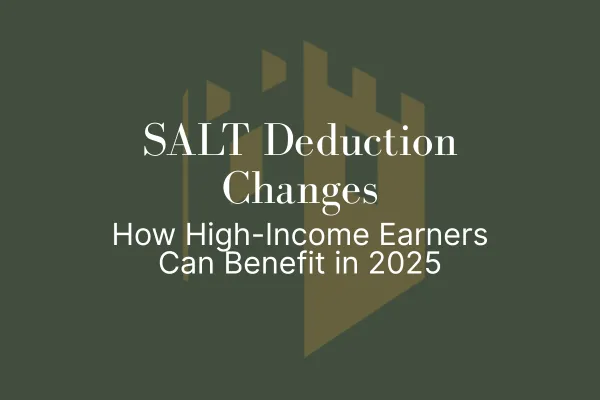
SALT Deduction Changes: How High-Income Earners Can Benefit in 2025
SALT Deduction Changes: How High-Income Earners Can Benefit in 2025
Keywords: SALT deduction 2025, state tax deduction limit, high income tax strategy, PTET workaround
If you live in a high-tax state like California, New York, or New Jersey, you've probably felt the sting of the $10,000 State and Local Tax (SALT) deduction cap since 2018. For many high-income earners, it turned into a stealth tax hike—especially for business owners, real estate investors, and fund managers.
Now, with the One Big Beautiful Bill Act (OBBBA), we finally have relief. But only if you know how to use it.
The SALT Cap Just Got a Raise—Here’s What Changed
The SALT deduction limit has been significantly revised:
New cap of $40,000 for filers with MAGI under $500,000
For MAGI over $500,000, the deduction phases out by 30% of the excess
A minimum deduction floor of $10,000 remains in place
PTET workarounds are preserved, which matters more than most people realize
This isn’t a full repeal, but it’s the most meaningful change since the original cap was introduced under the Tax Cuts and Jobs Act.
Why This Matters to Real Estate Investors and Business Owners
Let’s be clear: high-income earners in high-tax states have been subsidizing the rest of the country since 2018. If you’re paying $50K to $150K a year in state income tax and only deducting $10K of it, you’re leaving real money on the table.
With the new cap, many of our clients—especially those earning between $250K and $1M—are seeing five-figure improvements to their federal tax position.
But the real opportunity lies in combining this cap increase with the Pass-Through Entity Tax (PTET) strategy.
What Is PTET, and Why Should You Care?
PTET is a workaround that lets your S-Corp or partnership pay your state taxes on your behalf. Because the business pays it, the IRS sees it as a deductible business expense—not a capped personal tax deduction.
Here’s the flow:
Your pass-through entity pays your state tax
That payment is deducted at the entity level
You receive a K-1 showing reduced taxable income
The net effect: you sidestep the SALT cap altogether
And yes, the OBBBA explicitly preserved this strategy.
What This Looks Like in Practice
Let’s say you own an S-Corp in California and earn $800K.
Under old rules:
You pay $100K+ in state tax
You can only deduct $10K of it federally
That’s $90K in disallowed deduction
With PTET:
Your business pays the $100K as a state-level business tax
That full amount is deductible federally
You just saved $37,000 (assuming a 37% marginal rate)
Multiply that by the years you plan to operate, and the benefit becomes too large to ignore.
Action Items for High-Income Earners
Check your income thresholds
If you’re under $500K MAGI, you qualify for the full $40K cap. Above that, use PTET to avoid the phase-out.Use the right entity structure
S-Corps and partnerships are your best friends here. C-corps won’t help.Elect PTET on time
Every state has its own election deadline. Miss it, and the deduction is gone.Work with a CPA who knows the code
We’ve implemented this strategy for dozens of clients. Most CPAs miss it—or file it incorrectly.
Don’t Leave This to Chance
I’ve reviewed hundreds of tax returns for high-income clients in high-tax states. The most common mistake I see? CPAs failing to coordinate federal and state strategy.
The result? You’re overpaying. Quietly. Every year.
The SALT deduction update in OBBBA is a win—if you act on it. If you wait for your CPA to bring it up next March, you’re already behind.
Let’s figure out how much you’re overpaying—and what to do about it.





